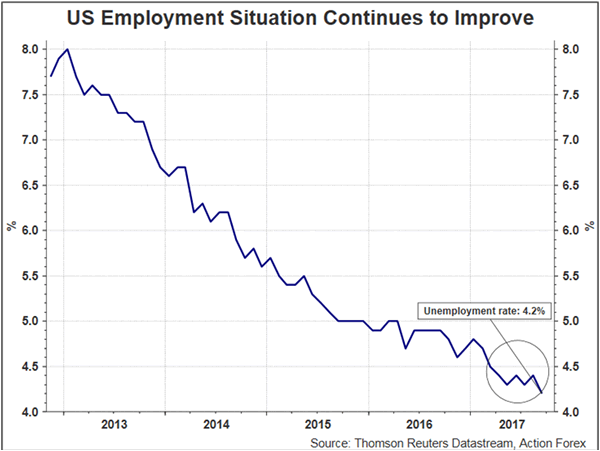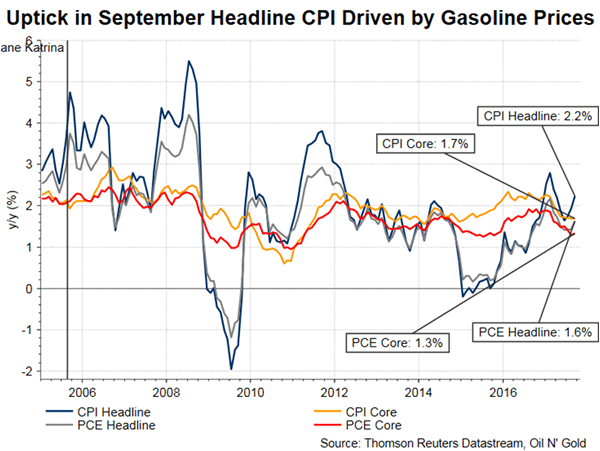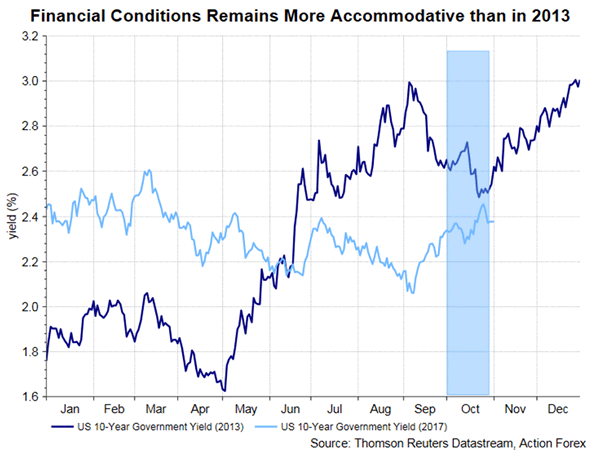As widely anticipated, the November FOMC meeting contained few changes from the previous one. The members left the target range of the Fed funds rate unchanged at 1-1.25%. One surprise came from the upgrade of the growth assessment to ‘solid’ for the first time since 2015, despite disruptions by hurricanes. Inflation stayed below the +2% target and the members acknowledged that core inflation ‘remained soft’. However, the encouraging growth outlook and further decline in the unemployment rate suggest that a December rate hike remains on track.
Policymakers upgraded the growth outlook and shrugged off the impacts of hurricanes. As noted in the accompanying statement, ‘economic activity has been rising at a solid rate despite hurricane-related disruptions. Although the hurricanes caused a drop in payroll employment in September, the unemployment rate declined further’. In September, they noted that that economic activity has been ‘rising moderately so far this year. Job gains have remained solid in recent months, and the unemployment rate has stayed low’. Recognizing growth as ‘solid’ for the first time in 2 years signaled that Fed’s confidence in the economic firm-footing. In shorts, the members were not concerned about the hurricane-related disruptions. They believed that ‘rebuilding will continue to affect economic activity, employment, and inflation in the near term, but past experience suggests that the storms are unlikely to materially alter the course of the national economy over the medium term’. At the same time, the Fed acknowledged the weakness on inflation, although hurricanes had boosted gasoline prices, which in turn lifted headline inflation in September. The members indicated that ‘inflation for items other than food and energy [core inflation] remained soft’. They noted that CPI measures ‘have declined this year and are running below +2%’. On net, the Fed continued to characterize the near-term risks to the economic outlook as ‘roughly balanced’, and it would continue ‘monitoring inflation developments closely’.
A highlight of the meeting was the update of the balance sheet reduction program which took effect in October. However, there was only brief touch on this issue. The statement suggested that balance sheet normalization was ‘initiated’ in October and ‘is proceeding’. There were no dissents. Last month, the Fed began the process of reducing its US$ 4.5 trillion balance sheet which is comprised mainly of bonds. In the plan announced in June, the Fed set an initial cap at US$ 10B/month. That is, the caps start for the first three months at US$6B and US$4B for Treasuries and MBS respectively, before rising each quarter until they reach US$30B and US$20B per month Treasuries and MBS respectively, by October 2018.
The November statement signals that the Fed is on track to raise the policy rate again in December, assuming no material deterioration of the economic development. The next focuses are the announcement of the next Fed chair (US President Donald Trump has intended to announce it Thursday US Time), a drafted tax reform bill and the November employment report due Friday.
















